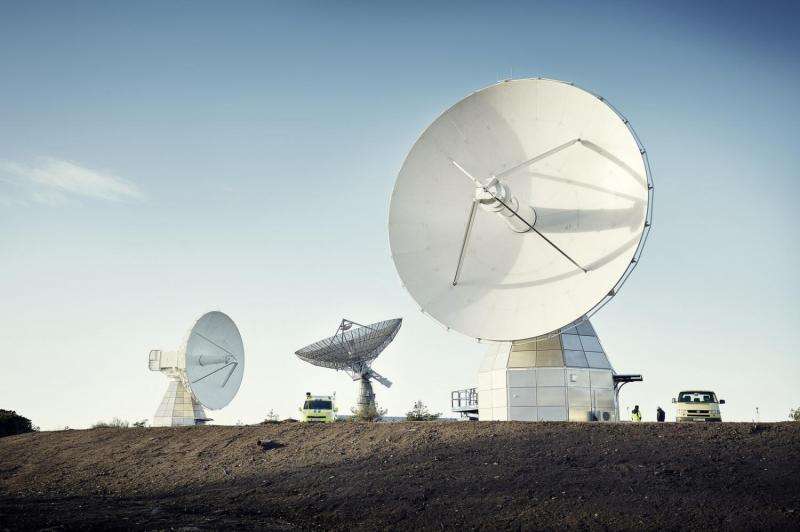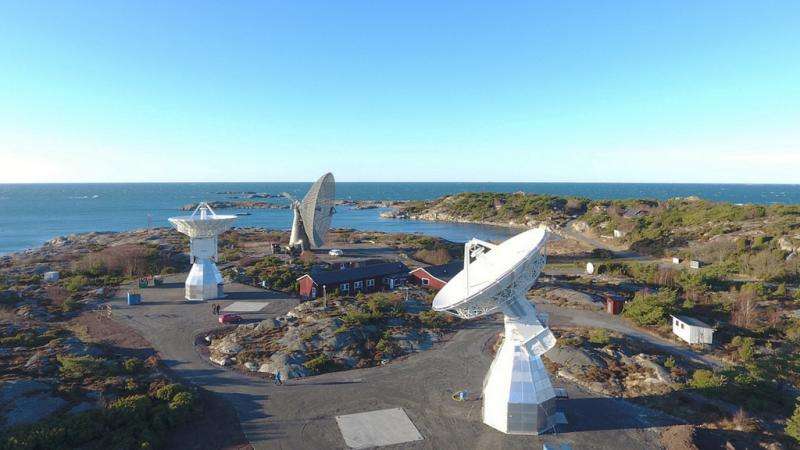Onsala Twin Telescopes ready for the world

Two new radio telescopes have been built at Onsala Space Observatory on Sweden's west coast, and on 18 May 2017 they will be inaugurated. The Onsala Twin Telescopes are part of an international network of radio telescopes that use astronomical techniques - and distant black holes - to make high-precision measurements of the Earth and how it moves.
The Onsala Twin Telescopes are two identical dish antennas, each 13.2 metres in diameter. They are part of an international initiative involving 20 countries, aimed at increasing our knowledge about the Earth and its movements.
The telescopes detect radio waves from brilliant but distant galaxies that act like fixed stars in the sky. By continually measuring the positions on the sky of bright radio galaxies, the telescopes in the network can determine their own location in space.
John Conway is professor in observational radio astronomy at Chalmers and director of Onsala Space Observatory.
"The sources that the telescopes measure are distant galaxies, each of which has at its centre a supermassive black hole whose surroundings shine brightly when the black hole consumes material. This is applied astronomy at its best" he says.
The Onsala Twin Telescopes are part of a growing international network of similar telescopes. As part of the global project VGOS (VLBI Global Observing System), they have company all over the world. Measurements of this kind have been carried out over the last few decades, and Onsala's 20-metre telescope has participated in these. But with a dedicated network of telescopes, observations can now be carried out 24 hours a day, all year round, and will be able to able to make measurements ten times as precise as is possible today.

"With the new network we will be able to measure distances between telescopes to millimetre precision, and almost in real time", says Rüdiger Haas, professor of space geodesy at Chalmers.
Onsala's history of geodetic measurements is a long one. In 1964, the observatory's iconic 25-metre radio telescope became the first in Europe to take part in geodetic VLBI (very long baseline interferometry). The observatory's 20-metre telescope, inaugurated in 1976, boasts geodetic measurements over a longer period than any other telescope in the world.
The new telescopes and their network meet global needs, as expressed in a resolution which was adopted by the General Assembly of the United Nations in February 2015. The resolution, A Global Geodetic Reference Frame for Sustainable Development, recognised for the first time the importance of coordinating geodetic measurements on a global scale. The resolution strengthened exisiting work in the UN initiative Global Geospatial Information Management (UN-GGIM) and with the Global Geodetic Reference Frame (GGRF).
"Future research on sustainable development and on the Earth as a system will require more reliable, long-term, high-precision measurements. The Onsala Twin Telescopes are a natural continuation of our already long history of such measurements in Onsala", says Gunnar Elgered, professor of electrical measurements and head of the Department of Earth and Space Science at Chalmers.

Similar telescopes are already in place in the United States, in Hawaii and Maryland, in Wettzell in Germany, in Yebes in Spain, on Santa Maria in the Azores, and on the Arctic Svalbard islands. New telescopes are planned for other locations, among them South Africa and Finland. Operations for the complete network of 16 or more stations are expected to start in 2020.
A reference system with this level of precision is also needed for many applications in Earth Sciences. It will become possible, for example, to measure sea level relative to the centre of the Earth, in order to test models for climate change. Data from the network will also be able to contribute to many other exciting areas of science, for example the movement of Earth's tectonic plates, the Earth's changing rotation and axial tilt.
The construction and installation of the Onsala Twin Telescopes has been funded by a generous grant from the Knut and Alice Wallenberg Foundation and Chalmers University of Technology.
Provided by Chalmers University of Technology


















